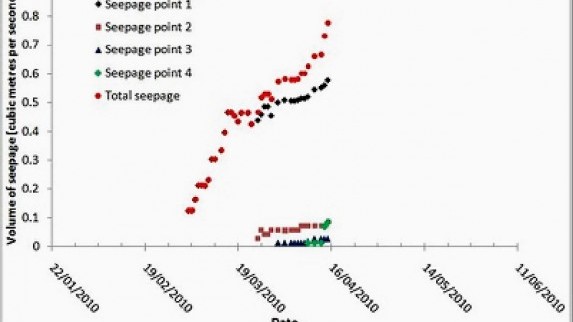
“The most likely cause of a sinkhole is that erosion is occurring in the core of the dam, although this could be localised. However, given that seepage is now accelerating again, the signs are worrying,” Patley writes.
The blogger goes on to record some key developments at the site that he says are worth noting. Foremost among these is that the rate of seepage has started to increase once again. The graph of seepage against time shows that seepage is increasing rapidly at the moment, albeit at rates that are still only a fraction of the inflow rate.
The key factor here is the development of a new seepage point on the dam face (seepage point 4), which is now producing about 85 litres per second of water. The location of the four seepage points is shown in the graph.
“Seepage points 2 and 3 cause me little concern given their location. Points 1 and 4 are clearly the ones that probably represent seepage from the lake,” he writes. Patley also reports that something strange is happening at Shishkat, which is near the head of the lake, probably best known for the location of the KKH bridge that has now been drowned. “Local people at Shiskat are reporting ‘underground blast-like sounds’ in the area,” he reports on the blog. “Of course there is little information about what these ‘blasts’ might be, or indeed the reliability of the reports. However, one possibility would be the development of slope instability on the banks of the lake,” he writes.
“Given that one failure mechanism for the dam is a slide into the lake and a wave that then overtops the dam, this needs to be checked out with some urgency,” Patley warns.
Noting the current situation at the landslide, he says the lake level continues to rise at 30 to 40 cm per day. This is perhaps slightly lower than expected as temperatures in this region remain unseasonably cold, meaning that snowmelt (and thus inflow) has been delayed. Based upon the current rate of rise of the lake level and downcutting of the channel, the water should reach the spillway in two to three months. This may shorten if the rate of inflow increases.



1730959638-0/trump-(19)1730959638-0-165x106.webp)













COMMENTS (7)
Comments are moderated and generally will be posted if they are on-topic and not abusive.
For more information, please see our Comments FAQ